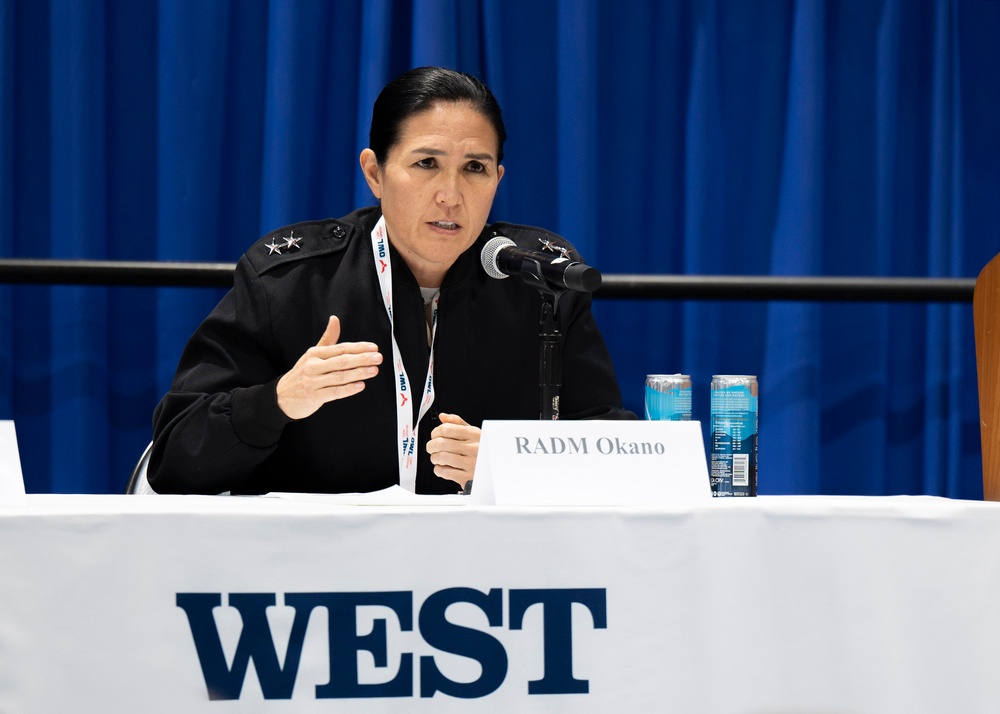At the 2025 WEST Conference in San Diego, Naval Information Warfare Systems Command (NAVWAR) reinforced its commitment to driving technological innovation and strengthening the Navy’s operational advantage. Through dynamic discussions, strategic engagements and live demonstrations, NAVWAR emphasized the need to rethink conventional approaches to warfare, as well as the role of artificial intelligence (AI) and machine learning (ML) tools to outpace emerging threats.
As the premier naval conference and exposition on the West Coast, WEST offered industry and academia experts the valuable opportunity to engage with U.S. Navy, Marine Corps and Coast Guard leaders. Co-sponsored by Armed Forces Communications & Electronics Association (AFCEA) International and the U.S. Naval Institute (USNI), thousands of people attended at the San Diego Convention Center Jan. 28-30 to discuss the landscape of increasingly complex challenges in alignment with the theme: the future is now, are we advancing operational capabilities that pace the threat?
NAVWAR Commander Rear Adm. Seiko Okano, representing the command for the first time at WEST, highlighted her organization’s commitment to supporting the Fleet with next-generation capability. On a panel with other military and industry experts, they discussed how the Department of Defense (DOD) is accelerating software development in support of the Replicator initiative, a DOD-wide effort to fast-track the acquisition of thousands of all-domain attritable autonomous systems.
She highlighted the need for a shift in both culture and the development ecosystem, emphasizing that transformative change is essential for driving progress. “This isn’t a technology problem; this is a culture problem. The faster we figure out how to shift this together, I think we win,” she said. “The Navy has always prided itself on having brilliant technologists at our research labs, but we should also embrace the really fantastic solutions from industry that we can leverage to help us innovate at speed.”
On another panel with systems commanders from the Navy, Marine Corps and Coast Guard on acquisitions, Okano continued to speak about the unique role NAVWAR has in delivering innovative capability to the Fleet. “NAVWAR is at the center of a significant shift in warfare—where traditional domains are blurring, and the fight is increasingly multi-domain and multi-spectral. Our role is to deliver a decisive information advantage, requiring speed, agility and adaptability,” she said. “The challenge is breaking down silos, fostering collaboration and instilling a culture that embraces rapid change to meet the demands of modern conflict.”
During an informational brief about NAVWAR and its needs, John Pope, executive director of NAVWAR, reiterated the importance of rapid and easy adoption of new technologies. “In our world of information warfare, we need to be the ones who are the quickest to respond to what the Fleet needs,” he said. “To achieve that, we’re asking our workforce and our industry and academic partners to embrace our core values of audacious innovation and radical ownership to get after what we need to fix any outdated equipment until we can find modern solutions.”
At the Navy’s Information Warfare pavilion, experts from across the NAVWAR enterprise had a significant presence, interfacing with industry at engagement zones and presenting cutting-edge technology. From Naval Information Warfare Center (NIWC) Pacific; Program Executive Office (PEO) Digital and Enterprise Services (Digital); PEO Manpower, Logistics and Business Solutions (MLB); and PEO Command, Control, Communications, Computers and Intelligence (C4I), NAVWAR’s wide-ranging program offices were represented on the exhibit floor.
The tech demonstrations from NIWC Pacific showcased the latest and greatest from their labs, ranging from cloud development to cryogenic probes to a robot dog designed to assist in ship maintenance. One of the demos featured a Rapid Recreation into Modeling and Simulations (R2MS) tool, spearheaded by the Integrated Fires Team. This platform uses real-world data to create live virtual simulations at rapid speed, an invaluable tool for training and mission planning. “We’re exploring how AI and ML can take R2MS’ capabilities even further,” said Nadil Lopez, project manager for the Integrated Fires team. “There is a lot of untapped potential with this tool in creating complex and realistic environments for the Fleet.”
All of NAVWAR’s PEOs also had significant industry engagement throughout the course of WEST. Through PEO C4I’s annual Engagement Event and the joint PEO Digital/MLB Industry Open house, around 250 individual companies met government representatives and leaders for insightful and collaborative conversations across all three PEOs. NIWC Pacific program managers and technical leads also met with industry through the engagement zones to discuss their needs in an informal one-on-one discussion.
“As underscored by several of the leadership keynotes this year, the rapid pace of both technological and global change demand stronger partnerships across government, industry and academia,” said Michael McMillan, executive director of NIWC Pacific. “WEST 2025 provides NIWC Pacific the opportunity to showcase our latest innovations while forging connections that accelerate the transition of critical technologies from research and prototyping to operational capability. By strengthening collaborations today, we ensure our Navy remains ahead of tomorrow’s threats.”
Efforts from PEO Digital were also acknowledged at the Department of Navy (DON) Information Technology Excellence Awards, held Monday, Jan. 27 prior to WEST. In honor of leading Flank Speed Zero Trust, the DOD’s first zero trust compliance pilot, Darren Turner received the Person of the Year award for his exceptional leadership and dual roles for both DON Chief Information Officer (CIO) and PEO Digital’s technical director office. Zero trust is a network security philosophy that states no one inside or outside the network should be trusted unless their identification has been thoroughly checked. The Navy’s Flank Speed service currently delivers enhanced collaboration, productivity and robust zero trust security to more than half a million users worldwide, completed three years before the DON CIO’s 2027 deadline.
Rodrick Adams, the Marine Corps Logistics Integrated Information Systems (LI2S-MC) security manager at PEO MLB, was also recognized with a Fiscal Year 2024 Copernicus Award from AFCEA International and USNI. This award honors individual contributions to C4I, information systems, cyber operations and information warfare. Adams’ efforts in leading the planning, development and implementation of the Naval Identity Services effort for Global Combat Support System-Marine Corps led to greatly enhanced financial transaction security for its users.
In continuing its commitment to helping the Navy reach new heights in cybersecurity and information warfare capabilities, NAVWAR leverages next-generation tools like AI/ML and industry partnerships to further drive innovation. As the battlefield becomes more complex, their role in the future fight demands a culture shift driven by collaboration, adaptability and agility.
About NAVWAR:
NAVWAR identifies, develops, delivers and sustains information warfighting capabilities and services that enable naval, joint, coalition and other national missions operating in warfighting domains from seabed to space and through cyberspace. NAVWAR consists of more than 11,000 civilian, active duty and reserve professionals located around the world.
| Date Taken: | 02.03.2025 |
| Date Posted: | 02.03.2025 17:30 |
| Story ID: | 490012 |
| Location: | SAN DIEGO, CALIFORNIA, US |
| Web Views: | 11 |
| Downloads: | 0 |
PUBLIC DOMAIN

This work, NAVWAR at WEST 2025: The Future of Multi-Domain Warfare Demands Agility and Audacious Innovation, by Lily Chen, identified by DVIDS, must comply with the restrictions shown on https://www.dvidshub.net/about/copyright.








